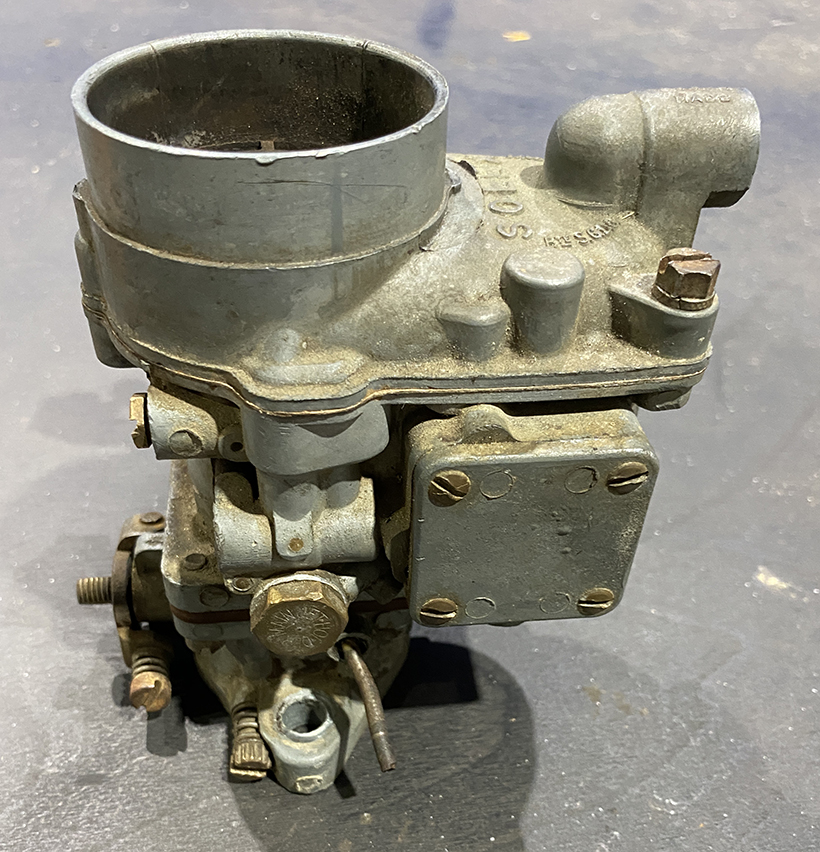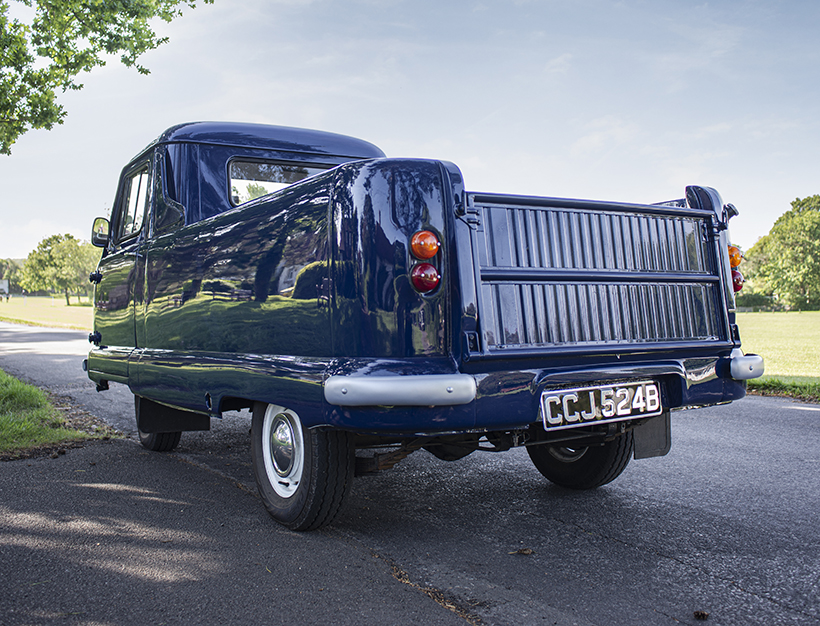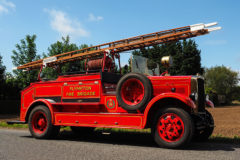Leyland 15 pick-up rebuild
Posted by Chris Graham on 12th July 2020
Paul Anderson undertook a unique Leyland 15 pick-up rebuild to create a support vehicle for his classic aeroplane. This is the story, in his own words.
Finished vehicle photos: Rana Dias

Leyland 15 pick-up rebuild: Paul Anderson’s beautifully-restored light commercial vehicle.
This Leyland 15 pick-up rebuild was unexpected. I really hadn’t set out even to buy a Leyland 15, let alone restore one! I wanted a Fordson E83W but, when I called to enquire about one I’d seen, it had been sold. My plan was to have a classic commercial to use as a support vehicle for my 1946 Stampe Biplane, that’s based at Headcorn in Kent, around seven miles from my home. The journey to the airfield is mainly single-track country lanes, so the roads are quiet and leafy – perfect for a classic commercial.
Headcorn, incidentally, is home to many vintage aircraft including Spitfires, Harvards, Tiger Moths and Stampes. Many of the pilots drive classic vehicles, and they really look great parked around, adding to the vintage appeal. A visit to Headcorn represents a brilliant – and free – family day out; watching the vintage aircraft take off and land, and the crazy people wing-walking! They also hold classic car days, and many of the regulars at Headcorn join the line-up of classics so people can get close-up and personal with the vehicles.
The search begins
Anyway, having decided on a classic commercial, but having lost the Fordson, I started looking around for something else that would do the job. That’s when I saw the Leyland 15 advertised in the South West Vehicle Auctions (SWVA) lot list. I really loved the look of it – though I fully accept it isn’t to everyone’s taste – but my mind was made up and I registered to bid online. Someone said: “Why would you want to buy it?”. My reply was simple: “You’ll never see another in the car park.” The auction moved fast and I bought Lot 22, Leyland 15cwt 1,670cc CCJ524B, for £5,300. It was a totally ‘blind’ purchase – I’d not seen, let alone looked over, the pick-up before bidding and buying.
SWVA delivered the Leyland four days later. It looked presentable, with a fairly new, wooden lining in the rear. But, on closer inspection, it was all very tired. It also took some starting, and needed full choke to it keep running. The gears were all moving freely, but the brakes were shot. The electrics worked in parts, and the interior looked like it needed a lot of help. I’ve rebuilt classic cars all my life, so none of this really phased me, and I was actually really pleased with my purchase. I thought I’d leave it for a couple of months, and just try to run it and work out what I really wanted to do with it.
However, during this time, the Fordson that I’d really wanted came back on the market; the new owner had, apparently, died and his collection was being sold. I made an offer that was accepted. This, however, meant that I had a dilemma as I’d started to really love the pick-up. My wife called it a frog, as it was green with big, headlight eyes. So, after much thought, I decided to get the Leyland 15 into good condition, and another project started.
The restoration
Restoring vehicles is never cheap, and this Leyland 15 pick-up rebuild was no exception. When I started to go through the vehicle, it was clear that quite a lot of work was needed. But, as it was such a rare vehicle, I thought it would be worth spending the money to get it into great condition. The engine was good so only a few small modifications, like a spin-on oil filter, were carried out. I did, however, renew the water pump, as it didn’t seem as efficient as it could be. The carburettor was split and distorted – I’ve never seen this before.

The Solex caburettor needed renewing and, although the replacement was better, it still needed a rebuild.
The Leyland 15 uses an unusual, Solex carburettor, and I managed to find one. It wasn’t in a great state, but the pick-up ran better with it fitted. I eventually had this carb rebuilt by Allan Wedgewood, whose father had worked for Solex many moons ago. His work is quite remarkable, and he turned it around for me in just a few days. The Leyland runs really well now. The only other modification was an electronic fuel pump, as the tank is right at the back and it’s quite a run to the carb. Again, the performance was transformed.
I ripped the wooden plywood liner out of the back, and found that some repair work had already been done to the bed, and it looked pretty good. I had two steel sides fabricated to make the inside of the bed area more robust, and also fabricated light covers so they weren’t exposed. The pick-up was taken pretty-much back to bare metal and painted a non-frog, Oxford Blue – the same colour as my Fordson – by Hi-Flight specialist paint finishes, based at Headcorn Aerodrome. The paint and colour have transformed the pick-up.

The plywood loadspace liner was removed, and the sides and base renovated extensively.
However, before the exterior paint was done, the interior was painted the original light grey colour, and a new roof lining was made by my good friend Mark, at M&K auto trimmers, in Aylesford, Kent. He also made a new parcel tray liner, front kick panels and a new floor mat for the front, using the original as a pattern.
Revealing cleaning
The seats looked brown but I put some WD40 on a household scouring sponge, and gave them a light wipe. The years of grime started to lift to reveal bright red seats underneath. I kept going with the WD40 and really liked the result, so I decided to leave the seats in their original fabric. A small repair had been done to the driver’s seat, and I have left this too, as it forms part of the pick-up’s history.

The restored cab interior. The seat coverings are original, and were transformed by a thorough – if somewhat unconventional – cleaning method. A passenger-side sun visor was often an optional extra on 1950s and ’60s commercials; if, indeed, one was offered at all.
I drove the vehicle back home from the trimmers via the M20, with no windscreen in place. It started to rain and it was like getting needles in your face constantly. However, I found the Leyland was really happy motoring along at 60mph with no issues. It’s actually surprisingly nippy.
I renewed the brakes all round, and had the wheels powder-coated and fitted new tyres. New chrome hub caps were found online. There was an issue, though; a strong smell of petrol. After much faffing and investigation, it was found that the fuel tank is suffering with pin-hole perforations all over the place. Aaron Radiator fabricated a new one, but it leaked. The tank went back three times and the issue was eventually resolved.
The fuel sender and gauge also caused no end of head-scratching. I use a company called Speedograph Richfield for gauge repairs, and they reprinted the face of the gauge and got it working. The only issue left to resolve was the fuel sender. I met Peter Foster, who is the spares co-ordinator of The Standard Motor Club, that covers the Leyland 15, and he had a new, old stock, sender. Problem solved.

The central instrument panel made it easier to produce LHD and RHD versions. The fuel gauge caused a few problems during the restoration.
Model history
The Leyland 15 was originally called the Standard 15, and was introduced at the 1962 Commercial Motor Show, as an update of the Standard Atlas Major. The original Standard Atlas’ were underpowered, as they only had a 948cc engine, but were designed for local deliveries, not for long runs. The 1960-‘62 Atlas Major had a 1,670cc engine (a sleeved-down version of the Standard Vanguard engine), and was much better for it. Peter told me of another club member with a Leyland 15 van but, as far as we know, the pick-up is the last remaining one on the road.
Many people understandable confuse the Leyland 15 with the Standard Atlas, and say they have seen a Leyland 15 on the road. In reality, though, what they’ve seen is a Standard Atlas. There are distinctive styling differences at the front. Amazingly, Peter had a photograph of my pick-up, which he took at an auction in Maidenhead, in 2002. His sister worked for the auctioneer and, as far as he can remember, the Leyland came from the Thornycroft collection of vehicles, assembled by the family who used to own the Thornycroft boat-building company.
On the road
For a classic commercial, you have to say that the Leyland-15 is a great drive. First gear is, as is common on classic commercials, very low, and you have to move up to second pretty-much as soon as you start moving. Once you’re in fourth gear, the Leyland just cruises along the road without issue. The vehicle didn’t come with a temperature gauge, but I fitted one as I really like to know if the engine is going to overheat. However, I’m pleased to report that it at ‘normal’, even on longer journeys. The drum brakes work very well, and the handbrake holds the pick-up on hills with no issues.

For a classic commercial, you have to say that the Leyland-15 is a great drive.
The driver’s seating position is brilliant; you sit forward with the engine at your side. This means you’re right on top of the front wheels, with excellent visibility, so parking is very simple. The Leyland also has a small turning circle, and you can really negotiate tight spots well. You can see why it was such a favourite for use in loading bays and warehouses. The central indicator switch, that forms part of the steering wheel centre and horn push, takes a bit of getting used to, but is remarkably easy to operate, and becomes second nature in time.
It’s remarkably comfortable for the driver and, although the suspension is firm, it’s not so bad that you feel it in your spine. The well-used seat still has plenty of spring in the base, and this takes a lot of the road bumps out. Overall, the Leyland is a great pick-up and handles modern traffic with ease.
The Leyland 15 pick-up rebuild wasn’t my first choice of project but, compared to my Fordson, the vehicle is a lot more practical. The pick-up drives and stops well, and makes friends wherever it goes. Even my wife loves the look of it now – high praise indeed. So, I’m glad I put in the time and effort needed to get the vehicle looking so good; it really did deserve to be saved. However, I don’t need two light commercials so, after much thought, I’ve decided to sell the Leyland and keep the Fordson which, after all, was the one I originally wanted. Hopefully it’ll go to a new owner who wants to use it as a true commercial vehicle should be used.

The finished vehicle from the rear. ‘CJ’ is a Herefordshire registration.
For a money-saving subscription to Classic & Vintage Commercials magazine, simply click here





